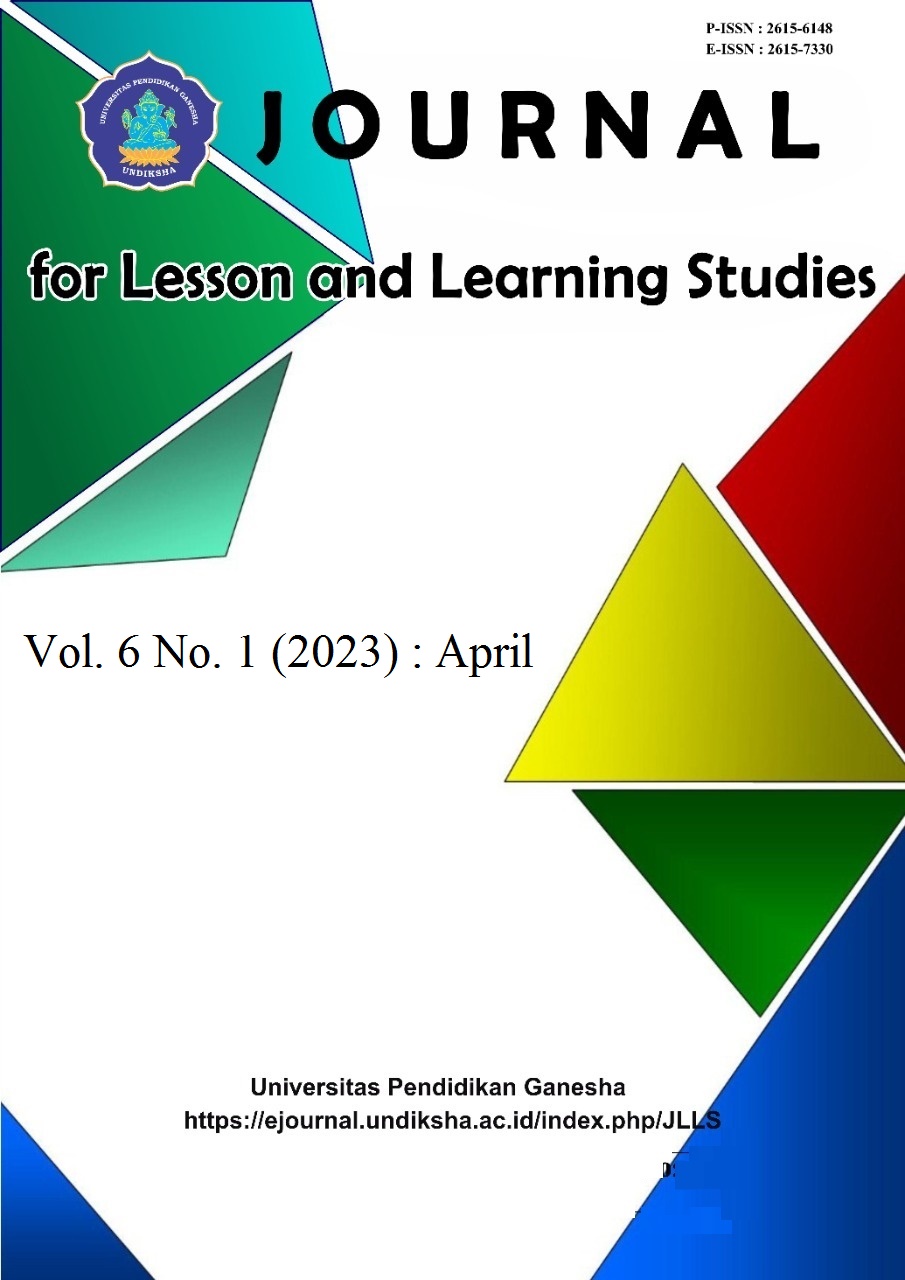Implementation of Content and Language Integrated Learning (CLIL) in Teaching English for Guiding
DOI:
https://doi.org/10.23887/jlls.v6i1.59570Keywords:
CLIL, English for Guiding, English DepartmentAbstract
In the globalization era, students are led to be able to have the interaction between countries and cultures. It causes the students to be proficient at using English as a communication tool. Besides, it is also used to compete globally. Therefore, this research aims to analyse content and language integrated learning (CLIL) implementation in English for Guiding of Diploma 3 of English Department. The data were gathered by documents study of the curriculum of study program, syllabus, and semester lesson plan of the course. This study used a qualitative approach on the basis of a qualitative study or an interpretive research design. Qualitative research is research that has the goal of analyzing data, especially the formation of new views that require the perspective of the respondent. The result found that the curriculum has explicitely stated that the students are expected to be able to use English in the area of tourism. It means both English proficiency and contents in tourism are obligatory delivered to the students. However, the syllabus and semester lesson plan give more emphasis on the students’ mastery on English with less attention given to the contents of tourism.
References
Akkerman, S. F., Bakker, A., & Penuel, W. R. (2021). Relevance of Educational Research: An Ontological Conceptualization. Educational Researcher, 50(6), 416–424. https://doi.org/10.3102/0013189X211028239. DOI: https://doi.org/10.3102/0013189X211028239
Asrial, A., Syahrial, S., Kurniawan, D. A., Subandiyo, M., & Amalina, N. (2019). Exploring obstacles in language learning among prospective primary school teacher. International Journal of Evaluation and Research in Education, 8(2), 249–254. https://doi.org/10.11591/ijere.v8i2.16700. DOI: https://doi.org/10.11591/ijere.v8i2.16700
Castellano-Risco, I., Alejo-González, R., & Piquer-Píriz, A. M. (2020). The development of receptive vocabulary in CLIL vs EFL: Is the learning context the main variable? System, 91, 102263. https://doi.org/https://doi.org/10.1016/j.system.2020.102263. DOI: https://doi.org/10.1016/j.system.2020.102263
Caterine, W., Amalia, T., & Shaberina, S. G. R. (2021). Indonesian EFL learners’ ability to comprehend and produce implicature. IDEAS: Journal on English Language Teaching and Learning, Linguistics and Literature, 9(2), 128–137. https://doi.org/10.24256/ideas.v9i2.1924. DOI: https://doi.org/10.24256/ideas.v9i2.1924
Denzin, N. K. (2020). Qualitative Inquiry in an International Space. International Review of Qualitative Research, 13(1), 3–4. https://doi.org/10.1177/1940844720920075. DOI: https://doi.org/10.1177/1940844720920075
Deswila, N., Kustati, M., Besral, B., & Sukandi, S. S. (2020). Content and language integrated learning (clil) approach across curriculum in science classrooms: are the english language use and learning reveal? Journal of Innovation in Educational and Cultural Research, 1(1), 15–21. https://doi.org/10.46843/jiecr.v1i1.4. DOI: https://doi.org/10.46843/jiecr.v1i1.4
Ellison, M., & Santos, Á. A. (2017). Implementing clil in schools: the case of the goclil project in portugal. E-TEALS, 8(1), 43–72. https://doi.org/10.2478/eteals-2018-0003. DOI: https://doi.org/10.2478/eteals-2018-0003
Evans, R., & Cleghorn, A. (2022). Do student teachers see what learners see? – Avoiding instructional dissonance when designing worksheets. South African Journal of Childhood Education, 12(1). https://doi.org/10.4102/sajce.v12i1.1015. DOI: https://doi.org/10.4102/sajce.v12i1.1015
Fatimah, A. S., & Santiana, S. (2017). Teaching in 21St Century: Students-Teachers’ Perceptions of Technology Use in the Classroom. Script Journal: Journal of Linguistic and English Teaching, 2(2), 125. https://doi.org/10.24903/sj.v2i2.132. DOI: https://doi.org/10.24903/sj.v2i2.132
Forey, G., & Cheung, L. M. E. (2019). The benefits of explicit teaching of language for curriculum learning in the physical education classroom. English for Specific Purposes, 54, 91–109. https://doi.org/10.1016/j.esp.2019.01.001. DOI: https://doi.org/10.1016/j.esp.2019.01.001
Friantary, H., Afriani, Z. L., & Nopitasari, Y. (2020). The Implementation of Indonesian Language Learning for Dyslexic in Children at Elementary Schools in Bengkulu. Linguists : Journal Of Linguistics and Language Teaching, 6(2), 23. https://doi.org/10.29300/ling.v6i2.3750. DOI: https://doi.org/10.29300/ling.v6i2.3750
Gabillon, Z. (2020). Revisiting clil: background, pedagogy, and theoretical underpinnings. Contextes et Didactiques, 15, 88–116. https://doi.org/10.4000/ced.1836. DOI: https://doi.org/10.4000/ced.1836
Goris, J. A., Denessen, E. J. P. G., & Verhoeven, L. T. W. (2019). Effects of content and language integrated learning in europe. European Educational Research Journal, 18(6), 675–698. https://doi.org/10.1177/1474904119872426. DOI: https://doi.org/10.1177/1474904119872426
Goris, J., Denessen, E., & Verhoeven, L. (2019). The contribution of clil to learners’ international orientation and efl confidence. The Language Learning Journal, 47(2), 246–256. https://doi.org/10.1080/09571736.2016.1275034. DOI: https://doi.org/10.1080/09571736.2016.1275034
Gunantar, D. A. (2016). the Impact of English As an International Language on English Language Teaching in Indonesia. Language Circle: Journal of Language and Literature, 10(2), 141–151. https://doi.org/10.15294/lc.v10i2.5621.
Hewi, L., & Shaleh, M. (2020). Refleksi Hasil PISA (The Programme For International Student Assesment): Upaya Perbaikan Bertumpu Pada Pendidikan Anak Usia Dini). Jurnal Golden Age, 4(01), 30–41. https://doi.org/10.29408/jga.v4i01.2018. DOI: https://doi.org/10.29408/jga.v4i01.2018
Huang, Y.-C. (2020). The effects of elementary students’ science learning in clil. English Language Teaching, 13(2), 1–15. https://doi.org/10.5539/elt.v13n2p1. DOI: https://doi.org/10.5539/elt.v13n2p1
Istri Aryani, I. G. A., & Rahayuni, N. K. S. (2016). Innovation of Teaching and Learning English Applied to Animal Sciences’ Student with the Combination of Computer Media and Audio Visual. International Journal of Linguistics, Literature and Culture, 2(1). https://doi.org/10.21744/ijllc.v2i1.5. DOI: https://doi.org/10.21744/ijllc.v2i1.5
Khoiriyah. (2021). Content and language integrated learning (clil) in indonesian. Jurnal Pendidikan Progresif, 11(3), 587–601. https://doi.org/10.23960/jpp.v11.i3.202110. DOI: https://doi.org/10.23960/jpp.v11.i3.202110
Lara, M. D. M., & Pedrosa, A. V. C. (2017). Teacher perspectives on clil implementation: a within-group comparison of key variables. Porta Linguarum: Revista Internacional de Didáctica de Las Lenguas Extranjeras, 29, 159–180. https://doi.org/10.30827/Digibug.54032. DOI: https://doi.org/10.30827/Digibug.54032
López-Hernández, A. (2021). Initial teacher education of primary english and clil teachers: an analysis of the training curricula in the universities of the madrid autonomous community (spain). International Journal of Learning, Teaching and Educational Research, 20(3), 132–150. https://doi.org/10.26803/ijlter.20.3.9. DOI: https://doi.org/10.26803/ijlter.20.3.9
Ma’ruf, H., & Sari, H. I. (2020). Teachers’ perspectives toward the implementation of bilingual immersion program in Indonesian private schools. EduLite: Journal of English Education, Literature and Culture, 5(1), 118–125. https://doi.org/10.30659/e.5.1.118-125. DOI: https://doi.org/10.30659/e.5.1.118-125
Mahmud, Y. S. (2020). Conceptualizing bilingual education programs through clil and genre-based approach: an indonesian context. VELES Voices of English Language Education Society, 4(1), 62–74. https://doi.org/10.29408/veles.v4i1.2005. DOI: https://doi.org/10.29408/veles.v4i1.2005
Malik, R. S. (2018). Educational Challenges in 21St Century and Sustainable Development. Journal of Sustainable Development Education and Research, 2(1), 9–20. https://doi.org/10.17509/jsder.v2i1.12266. DOI: https://doi.org/10.17509/jsder.v2i1.12266
Mannheimer, S., Pienta, A., Kirilova, D., Elman, C., & Wutich, A. (2019). Qualitative Data Sharing: Data Repositories and Academic Libraries as Key Partners in Addressing Challenges. American Behavioral Scientist, 63(5), 643–664. https://doi.org/10.1177/0002764218784991. DOI: https://doi.org/10.1177/0002764218784991
Martí, O., Moliner, L., & Alegre, F. (2022). When CLIL is for all: Improving learner motivation through peer-tutoring in Mathematics. System, 106(February), 102773. https://doi.org/10.1016/j.system.2022.102773. DOI: https://doi.org/10.1016/j.system.2022.102773
Paul, R., Norbury, C., & Gosse, C. (2018). Assessing students’ language for learning. Language Disorders from Infancy Through Adolescence, 440–502. https://doi.org/10.1016/b978-0-323-44234-3.00020-8. DOI: https://doi.org/10.1016/B978-0-323-44234-3.00020-8
Puspitasari, E. (2020). Mind mapping in clil: how it facilitates students’ reading comprehension. Journal of English Education and Teaching, 4(2), 154–169. https://doi.org/10.33369/jeet.4.2.154-169. DOI: https://doi.org/10.33369/jeet.4.2.154-169
Rodríguez-Dorans, E., Murray, F., de Andrade, M., Wyatt, J., & Stenhouse, R. (2021). Qualitative Inquiry, Activism, the Academy, and the Infinite Game: An Introduction to the Special Issue. International Review of Qualitative Research, 14(1), 3–16. https://doi.org/10.1177/1940844721991079. DOI: https://doi.org/10.1177/1940844721991079
Rojabi, A. R. (2020). Exploring EFL Students’ Perception of Online Learning via Microsoft Teams: University Level in Indonesia. English Language Teaching Educational Journal, 3(2), 163. https://doi.org/10.12928/eltej.v3i2.2349. DOI: https://doi.org/10.12928/eltej.v3i2.2349
Sarip, M. (2019). Model of content and language integrated learning (clil) strategy in arabic speaking subject. Arabiyat : Jurnal Pendidikan Bahasa Arab Dan Kebahasaaraban, 6(1), 53–70. https://doi.org/10.15408/a.v6i1.10371. DOI: https://doi.org/10.15408/a.v6i1.10371
Setyaningrum, R. W., & Purwati, O. (2020). Projecting the implementation feasibility of clil approach for teyl at primary schools in indonesia. JEES (Journal of English Educators Society), 5(1), 23–30. https://doi.org/10.21070/jees.v5i1.352. DOI: https://doi.org/10.21070/jees.v5i1.352
Simbolon, N. E. (2020). Clil practice in a maritime english course: efl students’ perception. EduLite: Journal of English Education, Literature and Culture, 5(2), 263–276. https://doi.org/10.30659/e.5.2.263-276. DOI: https://doi.org/10.30659/e.5.2.263-276
Sundari, H. (2016). The qualities of an effective English teacher: University students’ perception. TESOL Indonesia International Conference Edition: Teaching & Learning English in Indonesia-Future Trends and Approaches, 205–209.
Supina. (2018). Four Basic Skills Proficiency Based on Students’ Perception in Hospitality & Tourism Study Program, Bunda Mulia University. Journal of English Language and Culture, 8(2), 128–139. https://doi.org/10.30813/jelc.v8i2.1097. DOI: https://doi.org/10.30813/jelc.v8i2.1097
Tachaiyaphum, N., & Sukying, A. (2017). Efl pre-service teachers’ perceptions of clil. Asian Education Studies, 2(4), 44–56. https://doi.org/10.20849/aes.v2i4.283. DOI: https://doi.org/10.20849/aes.v2i4.283
Titarenko, L., & Little, C. B. (2017). International Cross-Cultural Online Learning and Teaching: Effective Tools and Approaches. American Journal of Distance Education, 31(2), 112–127. https://doi.org/10.1080/08923647.2017.1306767. DOI: https://doi.org/10.1080/08923647.2017.1306767
Xiao, J., & Li, M. (2019). a comparison of pupils’ motivation in integrated english and conventional elt in china. International Journal of Innovation and Research in Edcational Sciences, 6(5), 675–686.
Yang, W. (2018). The deployment of english learning strategies in the clil approach : a comparison study of taiwan and hong kong tertiary level contexts. Journal of English for Spesific Purpose at Tertiary Level, 6(1), 44–64. DOI: https://doi.org/10.18485/esptoday.2018.6.1.3
Yumelking, M. (2018). The implementation of bilingual education system (Indonesia–English) in frater private junior high school Maumere. At-Tadbir: Jurnal Manajemen Pendidikan Islam, 2(2), 1–12. https://doi.org/10.3454/at-tadbir.v2i2.3125.
Zaim, M. (2019). 5r strategy for implementing content and language integrated learning (clil). Proceedings Semirata 2019: International Seminar & Annual Meeting, September, 101–105.
Downloads
Published
How to Cite
Issue
Section
License
Copyright (c) 2023 Made Aryawan Adijaya

This work is licensed under a Creative Commons Attribution-ShareAlike 4.0 International License.
Authors who publish with the Journal for Lesson and Learning Studies agree to the following terms:
- Authors retain copyright and grant the journal the right of first publication with the work simultaneously licensed under a Creative Commons Attribution License (CC BY-SA 4.0) that allows others to share the work with an acknowledgment of the work's authorship and initial publication in this journal.
- Authors are able to enter into separate, additional contractual arrangements for the non-exclusive distribution of the journal's published version of the work (e.g., post it to an institutional repository or publish it in a book), with an acknowledgment of its initial publication in this journal.
- Authors are permitted and encouraged to post their work online (e.g., in institutional repositories or on their website) prior to and during the submission process, as it can lead to productive exchanges, as well as earlier and greater citation of published work. (See The Effect of Open Access)




